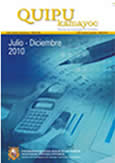VOLATILITY OF THE INDUSTRIALIZED ECONOMIES END AND THEIR IMPACT ON LATIN AMERICAN ECONOMIES: 2008 2010
DOI:
https://doi.org/10.15381/quipu.v17i34.4724Keywords:
Economías avanzadas, economías industrializadas, volatilidad de las economías, Economías de América Latina.Abstract
Governments of countries in crisis, especially in advanced economies seem to understand that the allocation of resources can not be left to market forces as the neo-classical liberalism argued that itself is the philosophical source of the process globalization. The intervention in the economy at the expense of incurring high deficit in some way contributed to the deepening recession is not more global. I think the severe recession scenarios of vulnerability in the advanced economies, such as in the financial sector and labor, which resulted in the closure of bank s loss of consumer confidence. Only North America together private spending reaches $ 6 billion, the contraction only 20% of this variable would represent a significant decline in Latin American countries that reach this market with its export. These results give a reading of dependency on Latin American economies to the volatility of the industrialized economies, countries whose volatility is immediately transmitted to the peripheral economies. The sensitivity of industrial economies has led to recede in their macroeconomic accounts, but contiavanzanued to lead the global economy, especially the United States whose contribution to global GDP on average reaches 23%, given this economic supremacy, financial and economic threads will be in charge of this country, so the Latin economies should adjust to global politics. Since there is no doubt that the United States, the unemployment rate approaches 10%, but always trump economic power. That is why any volatilization of this economy, together with the G20 and G7, the region would be violated. The symmetry between the advanced economies and those that are developing can be seen in all fields, financial and economic to political, but this does not imply that this region parallel progress in macroeconomic accounts, as does China and India that this trend continues, the latter two countries, along with other emerging economies come to dominate the world with a GDP would overtake the economies of developed countries. But no doubt that the revenue in the first world are better redistributed to companies whose earnings exceed the GDP largely poorer countries, this asymmetry is caused by the high concentration of wealth that is observed globally. The IMF argues that the economic recovery is underway and that the commodity-exporting economies will benefit, this position of the IMF is the clearest evidence that Latin American economies has to be well expected that industrialized countries have good economic performance, dependency theory does not explicitly indicated by this world body. There is no doubt that if the global economy advances, together with China, India and Russia, the raw material exporting countries in blue have their external accounts, but both economies will continue to live only on their comparative advantages, the scene of total instability. It is true that Latin American countries has had a slight release of the first world economies, yet there is a strong correlation between the advanced world and the region, which is why in 2009, which was the year where you felt greater global crisis, all Latin American countries experienced declines in their economic growth, except Peru, which had a slight growth below 1%. Finally it should be noted that asymmetries in the financial sector and economic development is a feature of the global economy, where the `advanced countries have the possibility of salvage operations equivalent to 4 times the GDP of a developing economy and also give license to save failing banks under the pretext of preventing the collapse of the global economy when we know that the correction of these gaps, passes through structural policies and global nature, where the asymmetries stop creating more room for vulnerability.
Downloads
Downloads
Published
Issue
Section
License
Copyright (c) 2010 Nicko Alberto Gomero gonzales, Ana María Gutiérrez Huby

This work is licensed under a Creative Commons Attribution-NonCommercial-ShareAlike 4.0 International License.
AUTHORS RETAIN THEIR RIGHTS:
a. Authors retain their trade mark rights and patent, and also on any process or procedure described in the article.
b. Authors retain their right to share, copy, distribute, perform and publicly communicate their article (eg, to place their article in an institutional repository or publish it in a book), with an acknowledgment of its initial publication in Quipukamayoc .
c. Authors retain theirs right to make a subsequent publication of their work, to use the article or any part thereof (eg a compilation of his papers, lecture notes, thesis, or a book), always indicating the source of publication (the originator of the work, journal, volume, number and date).






